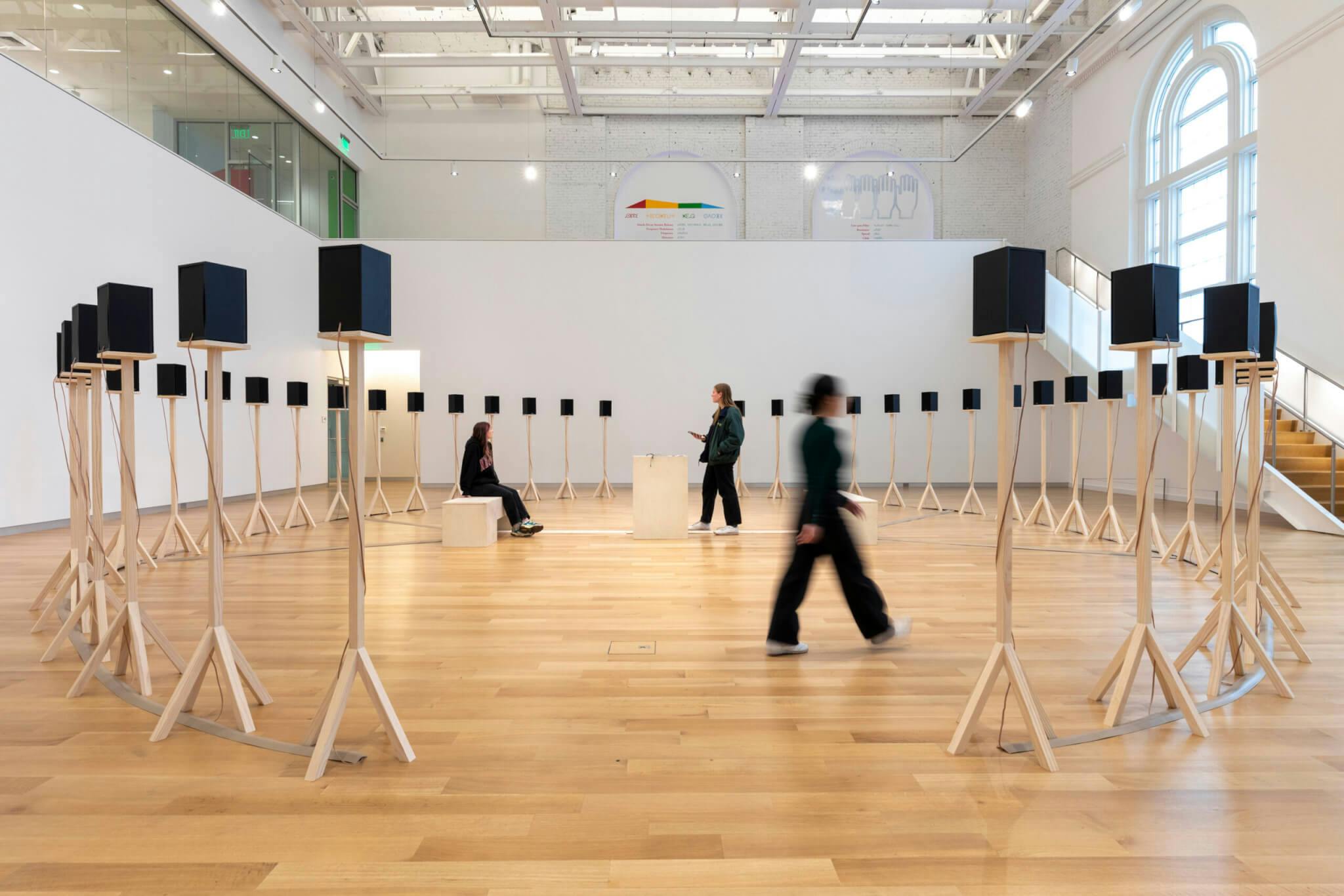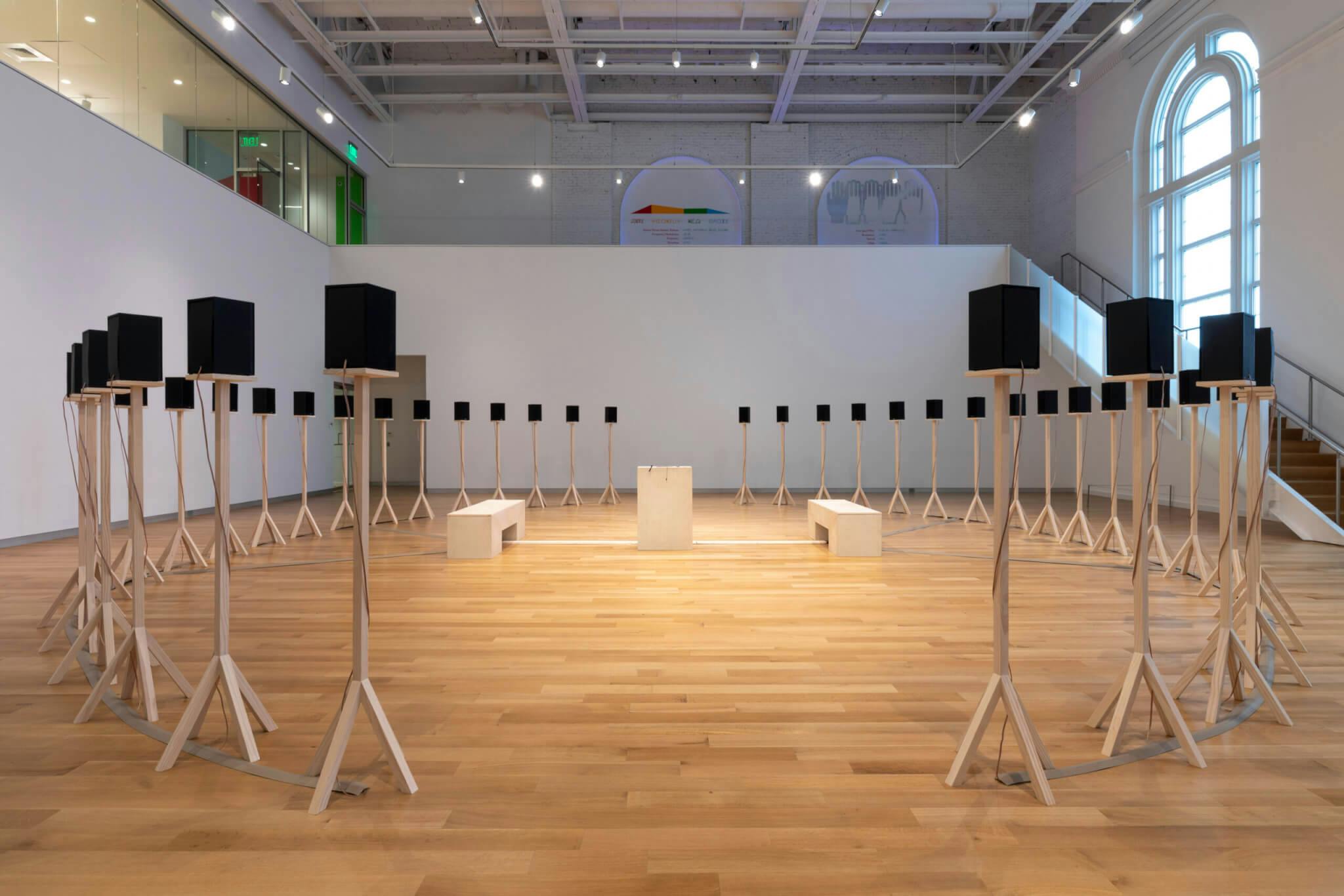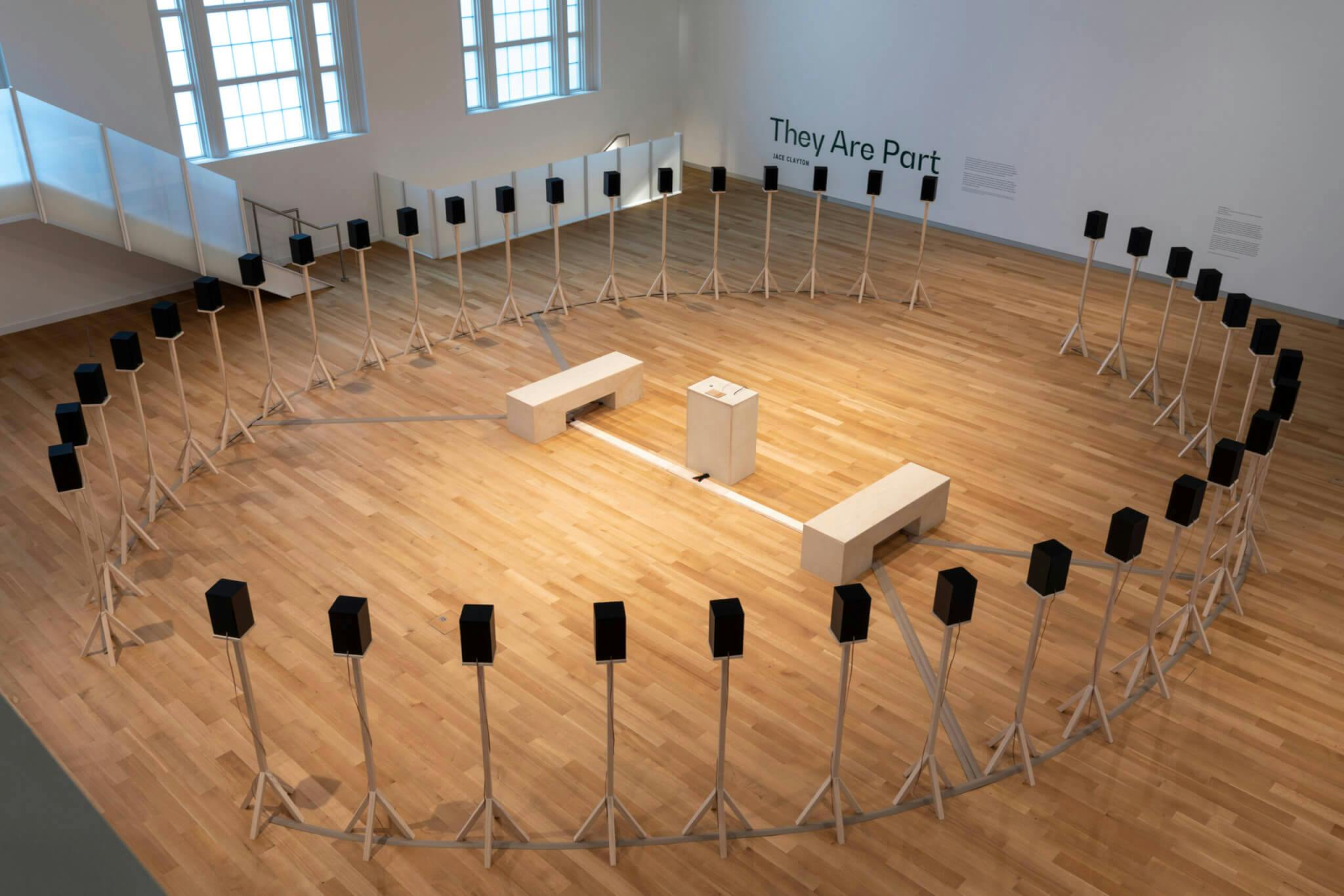Forty speakers stand in an ellipse. Two openings allow you to pass through the ensemble, along two benches, toward a waist-high wood plinth where aux cable, lightning cable, and Bluetooth enable you to conduct this chorus. Resting on custom birch stands, the speakers are positioned at eye level and angled inward, no longer transmitters and amplifiers of sound, but attentive bodies awaiting your input.
This silent anticipation is a central conceit of Jace Clayton’s 40 Part Part (2022), an interactive installation featured in the North Andover–raised artist’s first institutional exhibition in Boston. Clayton invites the public to coauthor this work, relying on the ready-made soundtracks available through their connected electronic devices. Staging un-playing “instruments” in a gesture recalling John Cage’s 4’33” (1952), Clayton seems as interested in the viewer’s experience of silence in awaiting action as he is in composed sounds. The silence of inaction, or more precisely in this work, before action, is still populated by noise—museum goers shuffling about tentatively, reading the wall labels and instructions engraved on the plinth, unsure of committing to filling the room with their music.
Clayton cultivates boldness, empowering a museum goer to subject strangers in this capacious open space on the MassArt Art Museum’s second floor (and its neighboring galleries) to a personal playlist. In semi-private settings, both real and virtual, music is curated through the contemporary mixtape, Spotify playlists and the like. 40 Part Part invokes these social transactions in the semi-public square, asking you to share before you receive. Instead of an eight-track playlist, visitors have a singular choice of song to interrupt the silence.
What does Clayton himself offer in this open proposition of plug and play? Drawing on his practice as a DJ, Clayton programs this installation with an unseen algorithm that modulates, compresses, and distorts the electronic input provided. The No. 1 hit in the museum goer’s device enters the world transformed, often vocalized first in a random corner before quickly traversing counter-clockwise across the congress of speakers. This spatialization of private sounds is immediately reminiscent of a cinematic experience, but noticeably more directionally hyper-specific as Dolby 7.1 is upgraded to forty parts. While surround-sound setups are often engineered to cleave environment from space, enclosing a viewer in a sonic womb, 40 Part Part remains intentionally porous. The track freezes, skids, skips; it passes through the thinnest high-pass filters, breaks down into the equivalent of 8-bit sounds of game over, never coalescing into an overwhelming tidal sonic wave. Without contorting the source material beyond recognition, Clayton’s algorithm injects the tracks with an animated ecstasy that experiments with every available frequency. The participant who offers this track undoubtedly fills in the blanks, continuing its melodies in their head when the speakers offer only delays and harmonies. Crucially, the title of the work itself recognizes that even the amplification of a singular track across a chorus of speakers is still yet a sliver of the fabric of sounds one experiences at any point in time; forty parts are still a part of an unruly whole.
Yet, one wonders whether 40 Part Part is truly social and connected to its larger environment or perhaps still forms a unilateral exchange between the artist and members of the public. On the lazy Sunday afternoon when I experienced the work, I watched as seven individual strangers fumbled to connect their devices, frowning quietly at choosing the perfect classical piano recording, flamenco accompaniment, and pop vocal ballad. Having become familiar with the connecting options, I helped when needed, listening and somewhat uncomfortably lingering on one of the two wooden benches. On a whim, I asked to connect my phone through the lightning cable while someone was broadcasting their song by Bluetooth. Although one more person could have conceivably joined us by aux cable, the two-track playback was pure chaos, the algorithm mutating from elegant contemplation into enraged rebellion. 40 Part Part wasn’t entitled 40 Part Parts for a reason.
While these chance encounters are indeed ephemeral, Clayton’s commitment to polyvocality is evident in this exhibition. First presented at the Cleveland Museum of Art (CMA) as a commissioned work by the FRONT International: Cleveland Triennial for Contemporary Art and the New York Philharmonic, 40 Part Part accumulates its own history of sound despite having no predetermined output. Originally conceived after Janet Cardiff’s The Forty Part Motet (2001) in the CMA collection, where a similar forty-speaker setup played a recording of Thomas Tallis’s 1573 religious composition “Spem in Alium” on loop, 40 Part Part engages local collections of music as Clayton works with choirs and their standard repertoires to produce new arrangements in performances sited in the exhibition space. Clayton also presents results of his research into North African musical theory in Sufi Plug Ins (2012–), a free-for-download software enabling electronic instruments to perform Arabic scales and polyrhythms. Installed less prominently in the interstitial passageway overlooking the main gallery space where 40 Part Part resides, this iteration of Sufi Plug Ins is displayed on a fully set-up computer and electronic keyboard, providing complete novices access to the prosumer software (Ableton Live) on which the plugin runs.
“They Are Part” surely allows the public an embodied experience to remember that the museum belongs to its people, in all their complexity and personal preferences. However, the artist, no matter how generous and humble, still remains as a crucial orchestrator to bridge and interpret, reminding us that unmediated interpersonal connection is not, and perhaps never was, our reality.
“Jace Clayton: They Are Part” is on view at the MassArt Art Museum through July 30, 2023.
This piece was originally published in Issue 10: RECALL, our spring/summer 2023 issue. Order it here.



